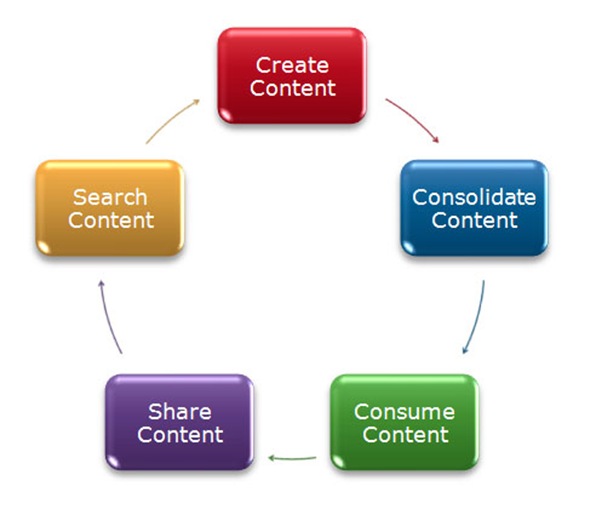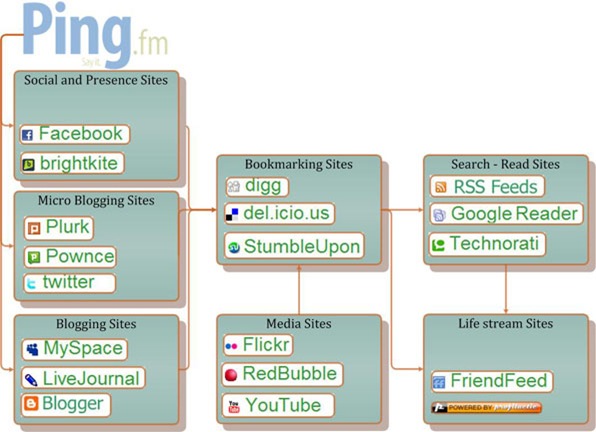Ping.fm Friend Feed and Profilactic
I’ve been wanting to write an article for some time now about how the social (web 2.0) web works, and why there are so many different sites out there. specifically I wanted to explain the use of sites like FriendFeed, Profilactic and Ping.fm
I have built a small diagram that hopefully illustrates a small portion of this. It is not comprehensive, though it is accurate in the detail it does show.
The missing stuff includes a dotted line back from any of the sites in the 2nd or 3rd columns back to the first column.
Let me explain the circle of internet life and how Ping.fm, Profilactic and Friend Feed play a part.

 You – the user – create content. This can be in the form of blog posts, comments on blog posts – yours or others, twitter microbloging, facebook status, what I’m listening to with MSN, Photos and videos that you upload to Flickr, YouTube or your blog etc. You update your work status on LinkedIn and join forums and debate or discuss things that interest you with others. You can use Ping.FM to send the same status message or microblog to all or any of the sites you are a member of.
You – the user – create content. This can be in the form of blog posts, comments on blog posts – yours or others, twitter microbloging, facebook status, what I’m listening to with MSN, Photos and videos that you upload to Flickr, YouTube or your blog etc. You update your work status on LinkedIn and join forums and debate or discuss things that interest you with others. You can use Ping.FM to send the same status message or microblog to all or any of the sites you are a member of.
 Applications like RSS Feed Readers (Google reader, RSS Bandit etc) along with sites like Profilactic and FriendFeed consolidate this content. You can create life streams for yourself, or for others that you follow. Even if you don’t do this you need to realise that others are. Your family members maybe watching and following your internet presence, not in a creepy big brother way, but in a sharing caring way – because they want to know what you think say or do. This especially applies to friends nd families who are widespread. I find that most people’s facebook accounts are filled with friends who are
Applications like RSS Feed Readers (Google reader, RSS Bandit etc) along with sites like Profilactic and FriendFeed consolidate this content. You can create life streams for yourself, or for others that you follow. Even if you don’t do this you need to realise that others are. Your family members maybe watching and following your internet presence, not in a creepy big brother way, but in a sharing caring way – because they want to know what you think say or do. This especially applies to friends nd families who are widespread. I find that most people’s facebook accounts are filled with friends who are
 As an internet user you consume content. You read blogs, view Facebook pages, interact with your friends on MySpace and MSN, read news articles, follow the football and read political debates in forums and comments on blogs. You look at friends and family pictures in Picasa Albums and watch videos on YouTube. In short you consume a lot of content. Some of this is done easily (using RSS Readers for example) and applications like Facebook make it easy to find out what all your friends have been up to with the status notifications feature. Other stuff is found the good old fashioned way using search. See that section for more details here.
As an internet user you consume content. You read blogs, view Facebook pages, interact with your friends on MySpace and MSN, read news articles, follow the football and read political debates in forums and comments on blogs. You look at friends and family pictures in Picasa Albums and watch videos on YouTube. In short you consume a lot of content. Some of this is done easily (using RSS Readers for example) and applications like Facebook make it easy to find out what all your friends have been up to with the status notifications feature. Other stuff is found the good old fashioned way using search. See that section for more details here.
Sharing is a little more complex to explain as there are so many ways to do it. However the basic concept can be summed up with the question “Have you ever sent an email to someone with a web link in it?” This is sharing. You have effectively acted in the best interest of your friend and forwarded something you thought they may be interested in. Sharing is just that. Taking information that you think is important and relaying it. Digg, Delicious and StumbleUpon are all services designed to help you make that easy to to do, and not just for your friends that you can email – but to anyone. SocialMedian is a news compilation service that can be used to pull specific news items from the web and tailor them into a feed that can be consumed by you or others. Sharing can be done by sending links in Facebook, MSN or email, or by writing a blog article. This article is just that – me sharing what I know about this to you.
We are nearly completing the circle. Part of the consume process is searching, but it is important enough to warrant its own item. Plus I needed to put 5 things into the little diagram! Searching is important because this is how your circle of knowledge and information expands. You might be sent a link to a news article or find something out, and that may open a whole new world up to you. Searching for additional information brings you to pages of information you never knew existed. You are able to find out something new.
And this helps close the loop int he cycle, because you now have the opportunity to educate or inform your friends, acquaintances and completely random fellow net citizens by sharing the information you just learned. Maybe by even writing a whole article about the research you just did, or maybe just sending a one line tweet about it. but by doing so you start the whole cycle again.
As a footnote – this article can be considered as a lead into the question “How do we leverage internal knowledge in an organisation?” The process described above can be managed as business process within an organisation. The difficulty is in creating a culture of sharing and openness.








Comments
A very thought provoking
A very thought provoking article. You just summed up what fascinates me so much about the internet. It's a complex maze world. You start off intending only to step through one door to get some information, only to find a multitude of other possibilities. At times this can be quite overwhelming.